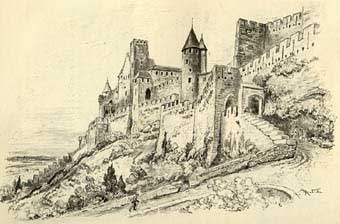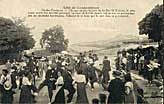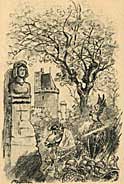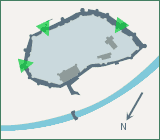 |
|
Fortifications watchman
|
|
|
| LIFE AROUND THE GATES
|
 |
| Paved slope, by Albert Robida |
For the citizens, the gates were important landmarks.
Every day, in the daily routine of the citizens, these gates
marked the boundary between the exterior and the interior, "when
you arrive at the drawbridge, you're there, you're home".
The Aude
Gate was the second big entrance to the city.
Accessible only by foot on a winding path, it is a remarkable
example of the art of fortification, but the citizens saw it
as, above all; an outdated, inconvenient entrance. "The
Préau was the centre of the world". The esplanade and
the garden in front of the drawbridge was the site of dances,
children's games, games of petanque, the meeting place for the
young and the "old folks" who, as they sat on a low wall, seemed
to form a symbolic guard.
 Tour
de l'âne (Donkey Ride) Tour
de l'âne (Donkey Ride)
The entrance to the drawbridge is watched over by two protectors;
on the outer ramparts by old Dame Carcas, the legendary
heroine namesake of the city, while a statue
of the Virgin defends the Narbonne
Gate which is set into the inner
wall. |
|

|
| |
Dame Carcas,
by Albert Robida |
| |
 |
|










 Tour
de l'âne (Donkey Ride)
Tour
de l'âne (Donkey Ride)





